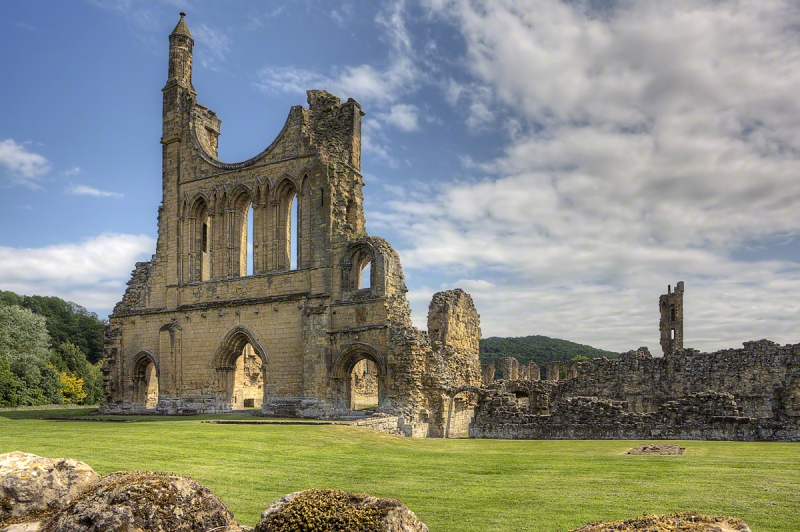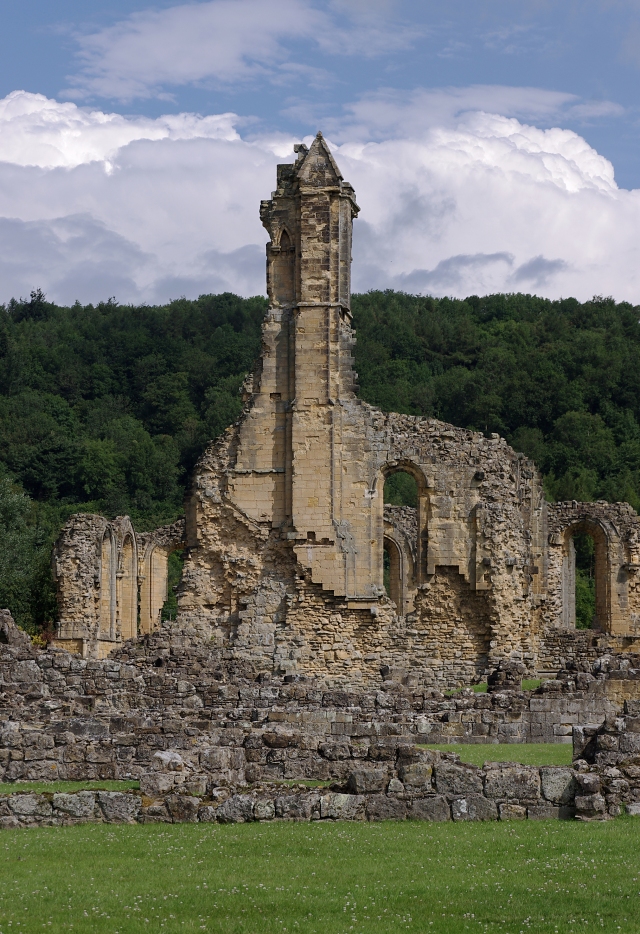
We get stuck behind a lorry and the road is so curvy, we stay stuck behind the lorry. A brown English Heritage sign on the left seems to be our salvation; "Byland Abbey" it reads, with an arrow pointing down another "clear" road.
During our weekly chats we'd discussed the possibility of visiting Byland, but it had fallen down in ranks to near the bottom of our "if we have time list", which hasn't yet become the "if we don't get lost" list. Double blessing here; we can get out from behind the lorry and get a great photo op. Just a quick stop for a few pictures, we agree, as we turn left.
Of course, at the last moment, the lorry turns left too. We're stuck behind him once again, but it isn't long before we round a broad curve and see Byland Abbey rising from a field in the distance.
Pulling into the car park for the Abbey Inn, a pub directly across the road from the abbey, we gather cameras and Great British Heritage passes. A road next to the abbey leads to an arched bridge and while Robin and I take pictures of this, Dana strikes up conversation with two gentlemen who are standing in front of the pub.
Seeking a better angle, Robin sits down in the middle of the narrow side-street next to the pub. I take a picture of some sheep in a field across the road while playing 'lookout' for her. It isn't long before I say, "Look out Robin, here comes a car." The car swings into the little carpark next to the pub and the driver climbs out.
"Americans?" he asks as he walks by, disgruntled and obviously none too pleased by Robin sitting in the road, (even though he'd not had to slow down at all.) "Yes," we respond. "Figures." He shakes his head and sneers at us, turns around and gets into his car again. Hmph! He must be having a very bad day, so bad that our presence has spoiled whatever appetite or thirst has brought him here.
Ah, but Byland calls – our first ruins to explore – so the offense we feel at his pronouncement is short lived. Robin and I cross the road and tramp through the damp grass to explore the ruins. Dana seemed content to continue discussion with the two Yorkshire gentlemen.
Like Castle Howard, Byland Abbey is so much more than I imagined from my first look at it. We have the place to ourselves, except for a lad who is mowing the grounds, and we time our photographs around him. There is so much left of this abbey after so many centuries. It doesn't look like much as we approach, but once inside the archway, it just goes on and on. Around every corner there is something more to explore.
I am particularly impressed with the medieval floor tiles which have withstood almost a thousand years of foot traffic and exposure to the elements, and a recurring pattern that is carved into columns and walls throughout the ruins. Also of particular interest are the remains of a tower, rising up so high into the clearing sky. It looks as if a stiff wind could topple it.
A quick peek at my wristwatch shows that we had better get moving if we aren't going to miss Fountains (we are not going to miss Fountains). We make quick purchases of guidebooks at the admissions booth, which is tended by a very nice woman, and head back to the car. Dana says her farewells to her newfound friends and we are on our way.

Byland Abbey was founded as a Savigniac abbey in January 1135 and was absorbed by the Cistercian order in 1147. It was not an easy start for the community, who had had to move five times before settling at New Byland, near Coxwold in 1177.
Its financial success was not as great as that of places like Rievaulx Abbey, but it was famed for its sheep rearing and wool exports. Its church was said to be among the finest 12th-century churches in Europe.
In the late 12th century the abbey had a complement of 36 monks and 100 lay brothers, but by the time of the dissolution in November 1538, the abbey was host only to 25 monks and an abbot.
Read more about Byland Abbey at Wikipedia.